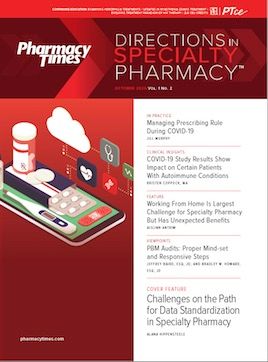Publication
Article
Specialty Pharmacy Times
“NASP in Action” Highlights Organization’s Efforts to Elevate Specialty Pharmacy
Author(s):
A session during the National Association of Specialty Pharmacy (NASP) 2020 Annual Meeting & Expo Virtual Experience, held September 14 to 18, 2020, highlighted some of the nonprofit’s activities.
A session during the National Association of Specialty Pharmacy (NASP) 2020 Annual Meeting & Expo Virtual Experience, held September 14 to 18, 2020, highlighted some of the nonprofit’s activities. Presenters reviewed NASP’s history and growth, top-tier federal policy priorities, and coronavirus disease 2019 (COVID-19) and its impact on specialty pharmacy advocacy efforts, as well as how members are currently engaging in advocacy and ways others can join.
During the session, “NASP in Action,” presenters provided their updates with a video recording using NASP’s virtual reality technology and concluded with a Zoom chat welcoming audience questions and comments. The session was presented by Keith Cook, RPh, president of the Specialty and Ambulatory Services Division at Comprehensive Pharmacy Services, and Julie Scott Allen, principal at Powers Pyles Sutter & Verville PC. Erik D. Halstrom, MBA, managing director at Turning Point and NASP secretary, moderated the session.
The objectives were to understand how NASP conducts government affairs advocacy, review policy priorities supported by NASP, outline congressional and regulatory actions, and illustrate the role NASP members can have in political and policy advocacy efforts.
Allen shared NASP’s top-tier federal policy priorities, which included reforming pharmacy direct and indirect remuneration clawback, establishing a new process for pharmacy performance evaluation, and defining specialty pharmacy. NASP also prioritizes pharmacy payment transparency and oversight and the recognition of specialty pharmacies as essential businesses.
Allen explained how COVID-19 has affected specialty pharmacy advocacy efforts, including timely access to specialty medication within the supply chain distribution and drug shortages, liability protections for pharmacies, small business loans, and COVID-19 vaccine education and access.
In his presentation, Cook encouraged NASP members to stay informed about specialty pharmacy issues and to get involved with these initiatives. He mentioned the many ways members can engage in advocacy, including joining the NASP Government Affairs Committee Forum, the NASP Policy Advisory Group, and the NASP Political Action Committee. Members can also participate in congressional site visits and town hall meetings and take advantage of the NASP Grass Roots Alerts.
Cook, Allen, and Halstrom emphasized the importance for all stakeholders in specialty pharmacy of paying attention to the issues affecting their industry and of engaging with the many NASP resources to advocate for specialty pharmacy as a collective unit.
NASP’s 130 corporate members and more than 1800 individual members include independent specialty pharmacies, pharmaceutical and biotechnology manufacturers, group purchasing organizations, patient advocacy groups, integrated delivery systems and health plans, technology and data management vendors, wholesalers and distributors, and practicing pharmacists.







